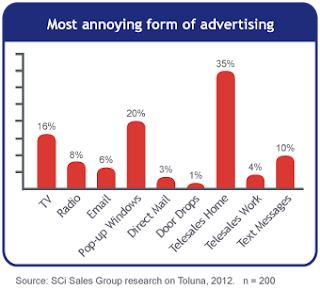One of the biggest obstacles that B2B telemarketing has to overcome is its perceived unpopularity with target audiences. But new research reveals a different picture.
There are many prejudices in marketing, but perhaps the most damaging is 'me, me, me marketing'; the assumption that you are typical of the target audience and that what you dislike, they will dislike.
We may have all received telemarketing calls at home that seem to come at just the wrong moment - when you are sitting down to eat your evening meal or when you're on a ladder changing a light-bulb :)
Some telesales calls at home can be annoying.
But new research shows that telesales calls at work are not viewed in the same way. There is a difference between B2C and B2B telemarketing.
We surveyed 200 ABC1 managers and asked them what was the most annoying form of advertising. Telesales calls at home came top of the list with 35%, but telesales at work was at the bottom with just 4%. Only Direct Mail and Door Drops were less annoying.
Pop-up windows on websites came 2nd and TV advertising 3rd. But note how both email marketing and text messages on mobile phones are considered to be more annoying forms of advertising than B2B telemarketing.
Why the difference between B2B and B2C telemarketing? It may be because most managers accept that it's part of their job to talk with new suppliers. Indeed, some buyers have a KPI on the number of new suppliers they meet - it's an effective way to ensure the company is getting the best deal.
But maybe the reason why it's preferred to email and mobile text messages is that it uses Human Interaction. Buyers are people - always have been, always will be - and relationships are important in business. It's easier to build a relationship and dialogue over the phone than via an email or text message.
Your brand's relationship with customers is shaped by the content and relevance of your marketing messages, but the channel you use may also have an impact.


No comments:
Post a Comment